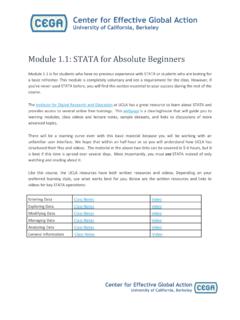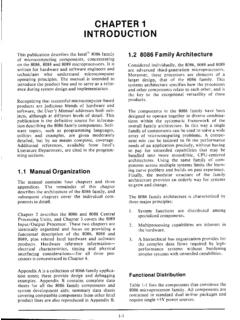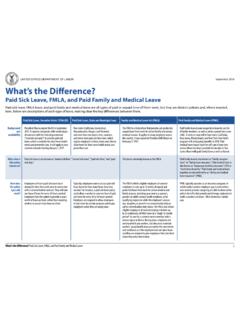Transcription of Module 2.5: Difference in Differences Designs - edX
1 Center for Effective Global Action University of California, Berkeley Module : Difference -in- Differences Designs Contents 1. Introduction .. 3 2. Basics of DID Designs .. 3 3. Demonstration: DID in Oportunidades .. 6 4. Matching and DID .. 12 Implementing PSM in 13 Evaluating the Impact of the Intervention .. 16 5. Tripple Difference in Differences .. 17 6. Bibliography/Further Reading .. 18 Learning Guide: Difference -in- Differences Center for Effective Global Action University of California, Berkeley List of Figures Figure 1. Graphical demonstration of Difference in Differences .. 5 Figure 2. Tabulation of number of villages by treatment groups and years .. 7 Figure 3. Number of treatment and control villages in year 2007 .. 7 Figure 4. Distribution of number of years of child (6-16 years) education in year 2000.
2 8 Figure 5. Distribution of number of years of child (6-16 years) education in year 2003 .. 9 Figure 6. Baseline balance in covariates and outcome of interest at year 2000 .. 10 Figure 7. Regression results for DID analysis .. 10 Figure 8. Regression results for DID analysis with covariates .. 11 Figure 9. Results of DID analysis with covariates using diff command .. 11 Figure 10. Logit regression to estimate the propensity scores .. 14 Figure 11. Output of pstest command to assess the improved balance after PSM .. 14 Figure 12. Graph of reduced bias in covariates after matching .. 15 Figure 13. Histogram of propensity score in treatment and control groups .. 15 Figure 14. Kernel distribution of propensity scores to demonstrate common support .. 16 Figure 15. Comparing DID with and without PSM .. 17 Learning Guide: Difference -in- Differences Center for Effective Global Action University of California, Berkeley Page | 3 1.
3 INTRODUCTION In previous modules, we have argued that Randomized Control Trials (RCT) are a gold standard because they make a minimal set of assumptions to infer causality: namely, under the randomization assumption, there is no selection bias (which arises from pre-existing Differences between the treatment and control groups). However, randomization does not always result in balanced groups, and without balance in observed covariates it is also less likely that unobserved covariates are balanced. Later, we explored Regression Discontinuity Designs (RDD) as a quasi-experimental approach when randomization is not feasible, allowing us to use a forcing variable to estimate the (local) causal effects around the discontinuity in eligibility for study participation. In RDD, we use our knowledge of the assignment rule to estimate causal effects. In this Module , we cover the popular quasi- or non-experimental method of Difference -in- Differences (DID) regression, which is used to estimate causal effect under certain assumptions through the analysis of panel data.
4 DID is typically used when randomization is not feasible. However, DID can also be used in analyzing RCT data, especially when we believe that randomization fails to balance the treatment and control groups at the baseline (particularly in observed or unobserved effect modifiers and confounders). DID approaches can be used with multi-period panel data and data with multiple treatment groups, but we will demonstrate a typical two-period and two-group DID design in this Module . We present analytical methods to estimate causal effects using DID Designs and introduce you to extensions to improve the precision and reduce the bias of such Designs . We conclude the Module with a discussion of Triple- Differences Designs (DDD) to introduce analysis allowing more than two groups or periods to be analyzed in DID Designs . The learning objectives of this Module are: Understanding the basics of DID Designs Estimating causal effects using regression analysis Incorporating matching techniques to improve precision and reduce bias in DID Designs Introducing Triple- Differences Designs .
5 2. BASICS OF DID Designs Imagine that we have data from a treatment groups and a control group at the baseline and endline. If we conduct a simple before-and-after comparison using the treatment group alone, then we likely cannot attribute the outcomes or impacts to the intervention. For example, if income from agricultural activities increases at the endline, then is this change attributable to the agriculture-based intervention or to a better market (higher demand and price), season, or something else that the intervention did not impact? If children s health improved over time, is it simply because they are getting older and having improved immune system or because of the intervention? In many cases, such baseline-endline comparison can be highly biased when evaluating causal effects on outcomes affected over time by factors other than the intervention. Learning Guide: Difference -in- Differences Center for Effective Global Action University of California, Berkeley Page | 4 A comparison at the endline between the treatment and control groups, on the other hand, may also be biased if these groups are unbalanced at the baseline.
6 DID Designs compare changes over time in treatment and control outcomes. Even under these circumstances, there often exist plausible assumptions under which we can control for time-invariant Differences in the treatment and control groups and estimate the causal effects of the intervention. Consider the following math to better understand the DID design concept. The outcome Yigt for an individual i at time t in group g (treatment or control) can be written as a function of: = + + 1 + 2 + 3 . + + where g captures group-level time-invariant (not changing over time) fixed effects (think of these as distinct Y-intercepts of the baseline outcome for each group); t captures period time-invariant fixed effects ( , election effects if the baseline was an election year ); G is an indicator variable for treatment (=1) or control (=0) groups; t is an indicator variable for baseline (=0) or endline/ (=1) measurements, the s are the regression coefficients to be estimated; Uigt captures individual-level factors that vary across groups and over time; and igt captures random error.
7 Let s denote the outcomes for the following four conditions as, At baseline in treatment group: 10= 1+ 0+ + + + 10+ 10 Individual at baseline in control group: 00= 0+ 0+ + + + 00+ 00 Individual at follow-up in treatment group: 11= 1+ 1+ + + + 11+ 11 Individual at follow-up in control group: 01= 0+ 1+ + + + 01+ 01 Change over time in outcome in treatment group = (4) (2): 11 10=( 1+ 1+ + + + 11+ 11) ( 1+ 0+ + + + 10+ 10) =( 1 0)+ 2+ 3+( 11 10)+( 11 10) Change over time in outcome in control group = (5) (3): 01 00=( 1 0)+ 2+( 01 00)+( 01 00) The average treatment effect (or the DID impact) = (6) (7) ( 11 10) ( 01 00)= 3+( 11 10 01+ 00)+( 11 10 01+ 00) = +( )+( ) Learning Guide: Difference -in- Differences Center for Effective Global Action University of California, Berkeley Page | 5 The final equation specified clarifies the assumptions needed in order to infer causality from DID Designs .
8 First, we expect that the regression error term has a distribution with mean 0, so that is also distributed with mean 0. Second, we assume that the time-variant Differences over time in the treatment and control groups are equal, thus cancelling each other out (U* = 0). This is a critical assumption made in DID analysis, allowing for causal analysis despite the absence of randomization, and in some cases we may not believe it to be true. The concept of DID is displayed in Figure 1. The solid red line shows how the outcome (some outcome of interest, measured in percentages) would change over time without the treatment (as measured in the control group), while the solid blue line displays the change over time in the treatment group. By shifting the red dotted line upwards from the solid red line, we remove the change over time attributable to other-than-treatment factors.
9 Therefore, DID design estimates the outcome attributable to the intervention. However, if the assumption that the changes in time-variant factors in treatment and control groups are equal does not hold (known as the Parallel Trend Assumption), then the true control outcome could track the red dashed line. As the figure demonstrates, we could overestimate (or underestimate) the causal effect using DID if the above assumption is violated. Figure 1. Graphical demonstration of Difference -in- Difference It is possible to control for factors that may vary or change over time differently between the treatment and control groups in regression analysis but one can always be concerned about immeasurable or unmeasured factors causing time variant changes. Also, mathematically, DID can also be shown as subtracting from the mean Difference at the endline between treatment and control groups the pre-existing Differences in these groups at the baseline.
10 Learning Guide: Difference -in- Differences Center for Effective Global Action University of California, Berkeley Page | 6 3. DEMONSTRATION: DID IN OPORTUNIDADES We will demonstrate application of DID with dataset for OPORTUNIDADES ( ). This is a panel dataset of household and individuals tracked in years 2000, 2003 and 2007. year 2000 was actually the final year of a previous version of OPORTUNIDADES called PROGRESA, which we studied in Modules , , and The PROGRESA treatment was randomized to 320 villages and 186 control villages. By the fall of 2000 all 506 treatment and control villages were included in OPORTUNIDADES. However, it wasn t decided to track the long term impacts of OPORTUNIDADES until 2003, but by that time the original controls had become the treatment, leaving only one option: to find a new control group.











